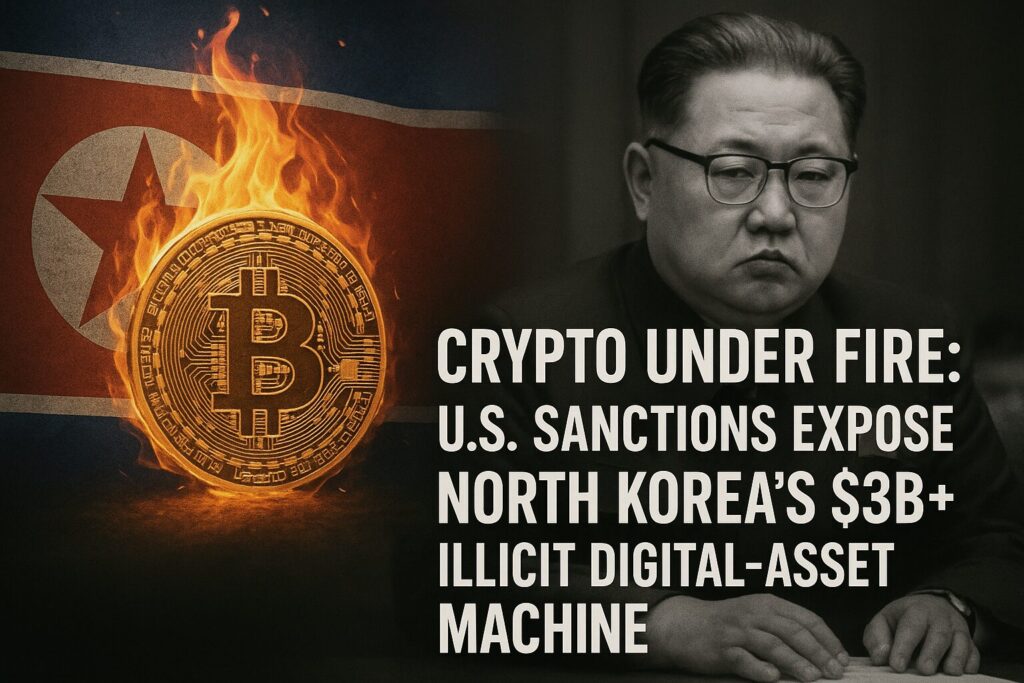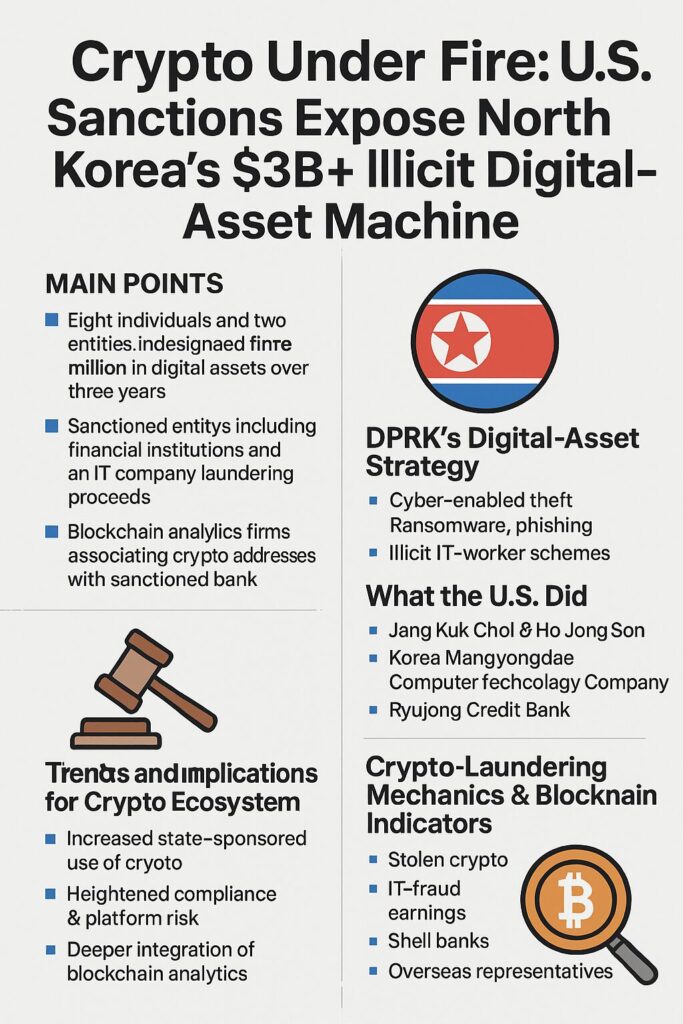
Main Points :

- The U.S. Department of the Treasury (via Office of Foreign Assets Control (OFAC)) has designated eight individuals and two entities linked to the Democratic People’s Republic of Korea (DPRK) for laundering funds derived from cyber-crime and illegal IT-worker schemes.
- The DPRK has stolen more than US$3 billion in cryptocurrency and other digital assets over the past three years, according to U.S. authorities.
- The sanctioned entities include a North Korean bank, two North Korea-based financial institutions, and an IT company that recruits global workers to launder the proceeds.
- Blockchain analytics firms are linking dozens of crypto addresses to the sanctioned bank, illustrating the evolving cat-and-mouse game of digital-asset flows and sanctions compliance.
- For practitioners, investors and technologists in the cryptocurrency space, this signals elevated regulatory risk, the increasing targeting of crypto channels for illicit finance, and reinforces the importance of compliance, de-risking and transparency.
1. Background: DPRK’s Digital-Asset Strategy
Over recent years, the DPRK has dramatically expanded its use of cyber-enabled theft, ransomware, phishing, illicit IT-worker schemes and digital-asset laundering as a means of generating foreign currency. The Treasury states that hackers backed by the regime “steal and launder money to fund the regime’s nuclear weapons program.”
In the crypto ecosystem, this has manifested in large exchange-heists, exploitations of centralized and decentralized finance, use of mixing/tumbling services, and sophisticated laundering chains involving shell companies and cross-border financial agents.
A landmark case in February 2025 alleged the DPRK’s responsibility for a $1.4 billion heist from Bybit, underscoring the scale of the threat.
2. What the U.S. Did: Sanctions and Designations
On November 4, 2025, OFAC announced sanctions against eight individuals and two entities connected to the DPRK’s laundering apparatus.
Key designated parties include:
- Jang Kuk Chol and Ho Jong Son — North-Korean bankers accused of managing approximately US$5.3 million in cryptocurrency for a previously sanctioned bank.
- Korea Mangyongdae Computer Technology Company (KMCTC) — a North-Korean IT company alleged to operate overseas worker schemes and use Chinese nationals as proxy bank-agents.
- Ryujong Credit Bank — a financial institution facilitating sanctions-evasion between China and the DPRK, including foreign-currency earnings and remittances for North Korean overseas workers.
The effect: all U.S.-based assets of these parties are frozen, and U.S. persons are prohibited from dealing with them.
3. Crypto-Laundering Mechanics & Blockchain Indicators
The sanctions notice emphasises a sophisticated laundering apparatus: stolen crypto, IT-fraud earnings, shell banks and overseas representatives.
For example:
- OFAC’s list includes 53 crypto addresses linked to the previously-sanctioned bank, Cheil Credit Bank, with an estimated US$5.4 million in associated funds.
- Analytics firms like Elliptic estimate the DPRK’s crypto theft in 2025 alone exceeded US$2 billion.
- Methods include malware, social engineering, employment of remote IT workers with concealed nationalities, and layering of crypto via proxy accounts and mixing services.
From the perspective of blockchain investors and projects, this activity raises the stakes: not only is regulatory scrutiny growing, but the presence of illicit flows imposes higher compliance, AML/KYC burdens, and reputational risk.
4. Trends and Emerging Implications for Crypto Ecosystem
a) Increased State-Sponsored Use of Crypto
The DPRK’s model demonstrates how a nation state can weaponise crypto. The scale and sophistication suggest that next-generation heists and laundering will continue to target digital-asset platforms, DeFi, mixers, and cross-chain bridges. The fact that the U.S. Treasury references “a scale unmatched by any other country” underscores that this is not niche criminality but major geopolitically-driven abuse.
b) Heightened Compliance & Platform Risk
Exchanges, custodians, DeFi protocols and token projects must be especially vigilant: sanctions lists are now explicitly associating crypto addresses with state-sponsored actors. Firms must monitor for addresses tied to DPRK-linked institutions and be ready for regulatory enforcement. The listing of 53 crypto addresses demonstrates tangible enforcement capability.
c) Deeper Integration of Blockchain Analytics
Analytics firms are deploying next-gen tools to trace laundering flows, identify proxy addresses, and enforce compliance against sanctioned actors. This fosters an environment where transparency and traceability in blockchain become competitive and regulatory imperatives.
d) Opportunity for “Clean” Innovation & Institutional Entry
As regulatory scrutiny increases, projects that emphasise transparency, compliance-friendly architecture and credible AML/CTF frameworks gain advantage. Blockchain platforms, token issuers and wallets that can demonstrably avoid exposure to illicit flows may attract more institutional interest. For new crypto assets and blockchain-application innovators (like your wallet project), the signal is clear: rigorous compliance and proactive risk management are part of the opportunity, not just cost.
5. What It Means for New Assets, Income Streams & Practical Blockchain Use
For readers seeking new crypto assets, revenue opportunities or practical blockchain implementations, here are specific implications:
- Asset selection: With state-abuse of crypto more visible, “clean” assets — those with transparent tokenomics, well-audited contracts, clear legal jurisdiction and compliance-aware teams — may be more resilient to regulatory shock.
- Emerging utility: Projects that enhance AML/CTF, address traceability, or support compliance tooling may benefit. For example, platforms integrating chain-analysis, provenance or “clean-chain” verification might offer utility beyond pure speculation.
- Blockchain infrastructure: Wallets, exchanges or bridges that embed compliance, sanction-screening, whitelisting, address-reputation ratings or analytics features can stand out. In your case (non-custodial wallet enabling BTC⇄ETH swaps), considering built-in address-sanctions-screening or partnering with analytics providers may enhance trust and institutional potential.
- Revenue models: As regulatory and compliance burdens increase, services that help projects, exchanges or institutions meet these burdens (e.g., analytics-as-a-service, sanction-screening APIs, compliance dashboards) may generate recurring income streams.
- Risk mitigation: Avoiding association (directly or indirectly) with illicit flows is critical. Projects must institute robust KYC/AML, whitelist monitoring, ongoing risk assessments. For token issuers, working with forensic firms and maintaining clean-fundraise and clean-onboarding practices is a competitive distinguishing factor.
6. Global Regulatory & Geo-Political Ramifications
The sanctions reflect a broader trend: digital assets are increasingly at the intersection of national security, sanctions-evasion and geopolitical competition. The U.S. is employing crypto-financial enforcement to go after state-sponsored illicit revenue.
For jurisdictions like Japan or the Philippines (where you operate), this means:
- Greater coordination between financial regulators, crypto-asset supervisors and national security agencies.
- A heightened expectation of cross-border transaction monitoring, enhanced due-diligence on counterparties, and rapid response to suspicious flows.
- For VASPs (Virtual Asset Service Providers) and EMIs operating cross-border, the risk of secondary sanctions, de-risking by global banks or counterparties, and increased cost of onboarding may escalate.
Conclusion
The latest sanctions action by the U.S. Treasury underscores a pivotal truth for the crypto ecosystem: digital assets are no longer a niche financial innovation untouched by geopolitics or national-security enforcement. Rather, they are now a battleground where states exploit cyber-crime and crypto-laundering to fund weapons programs and evade sanctions. For innovators, investors and infrastructure-builders in the blockchain space, the implications are multifaceted: the risks of association with illicit flows are real, compliance and transparency matter more than ever, but so do the opportunities to build “clean,” compliant and resilient systems that the next wave of institutional capital may require.
In your pursuit of new crypto assets, income streams and practical blockchain applications, keep this regulatory shift front-of-mind: the projects and platforms that treat compliance as strategic rather than overhead will be in a stronger position to capture value, reduce risk and earn trust in a landscape where digital-asset legitimacy increasingly matters.

